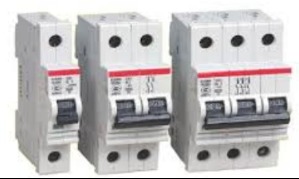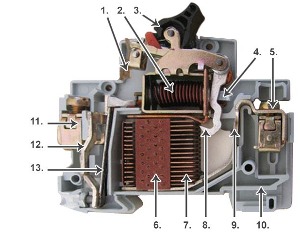
A miniature circuit breaker is a safety switch that protects an electrical circuit from overcurrent or power surge.
It is a protective device that interrupts the circuit when there are high currents. The primary function of a miniature circuit breaker is to protect an installation or branch circuit against high current arising from overload or short circuit.
They do the same work with fuse. However, MCBs are more advanced.
How miniature circuit breakers work?
MCBs work like molded case circuit breakers by protecting the electrical systems from overload and short circuit current.
They do that using the thermal and magnetic trips mechanism.
Thermal tripping for overload protection
When there is a high load on the circuit, the bimetallic strip of the breaker gets heated and thus bends away, releasing the mechanical lash. The lash triggers the breaker to turn off.
Once it is off, it will require you to switch it on again before it will start working.
Magnetic tripping for short circuit protection
When there is a short circuit, the current rises suddenly in an unstable way. Causing the electromechanical displacement of the plunger from the solenoids.
The plunger strikes the trip lever, causing the immediate release of the latch mechanism which opens the circuit breaker contacts.
Types of MCBs according to their trip curves.
There are several types of MCB switches based on their trip curves. But before that, let us know the meaning of a trip curve.
The trip curve is the highest current an MCB can withstand before tripping off. Their various types are Type B, C, D, K, and Z.
Type B.
This circuit breaker trips when the current is 3 to 5 times above the current rating. They are used in residential appliances and in some commercial applications where the surge current is low.
Type C
This type of MCB trip when the current is 5 to 10 times higher than the current rating.
They are used in commercial industries where there may be greater chances of short-circuits and overloads.
Items they protect include transformers, fluorescent servers, printers, and pcs.
Type D
This circuit breaker trips when the current rate is 10 to 20 times higher than the current rating.
They are used in big industries where the inrush current is high. For example; X-ray machines, winding motors, big transformers, and so forth.
Type K
This type of MCB trips when the current is 10 to 12 times above the current rating. They are suitable for inductive and motor loads with high inrush currents.
Type Z
This MCB trips when the current is 2 to 3 times above the current rating. They are sensitive to short circuits and are suitable for protecting sensitive devices, such as semiconductor devices.
Parts of an MCB.

1. Latch
2. Solenoid
3. Switch
4. Plunger,
5. Incoming Terminal
6. Arc Chute Holder
7. Arc Chutes
8. Dynamic Contact
9. Fixed Contact
10. Din Rail Holder
11. Outgoing Terminal
12. Bi-metallic Strip Carrier
13. Bi-metallic Strip
Types of MCBs based on the number of poles
Another way of classifying MCBs is on the number of poles they have. We have:
1. Single Pole MCB
A single-pole circuit breaker has one switch and also protects a single phase of the circuit.
2. Double pole miniature circuit breaker
The double pole MCB has two switches and also protects two-phase and is neutral.
3. Triple Pole MCB
A three-pole circuit breaker has 3 switches, and they also protect the three phases.
4. Three poles with a neutral
Three poles and a neutral circuit breaker protect the three phases of the circuit. It also has a neutral switch.
5. Four Poles
A four-pole MCB contains four switches, three phases, and a neutral. But unlike the three poles with neutral, the four poles protect all the phases and the neutral.
They are used in places with an unbalanced circuit.
MCB rating
This is the value of the current an MCB can withstand without tripping. It is fixed and ranges from 1A to 100A.
How to Select right MCB for Your Home.
When selecting your desired breaker, consider:
- Rated current: This is the maximum current the breaker can withstand without tripping. During selection, make sure you calculate the total current the circuit can carry and then match it with equal mcb.
- Breaking capacity: This is the maximum current the breaker can carry and break. Higher current above the breaking capacity will damage the breaker. 6kA and 10kA breaking capacities are suitable for residential use. Others with higher breaking capacities are used in industries.
- Number of poles: consider the number of poles you want the miniature breaker to protect and choose appropriately.
FAQ
Why is MCBs preferred to fuse?
MCB and fuse do the same work. However, MCBs are preferred because they last longer and don’t need a replacement after each trip.
What is the difference between MCBs and RCDs (GFCI)?
Residual circuit devices (RCDs) and miniature circuit breakers (MCBs) are both protective devices. However, they protect different things.
RCDs or ground fault circuit interrupters (GFCI) protect humans from electric shocks, which may arise from a ground fault. Meanwhile, MCBs protect appliances and electrical systems from high voltage.
What is the difference between MCBs and MCCBs?
MCBs and molded case circuit breakers (MCCBs) are the same. Their only difference lies in their trip curve. The trip curve of MCBs is not adjustable and is all sub-100 amp devices designed for low-voltage circuits.
While MCCBs have an adjustable trip curve and can be used on high-voltage circuits.
Related articles
- How to wire a Circuit Breaker Box
- What is a Motor Protection Circuit Breaker?
- What are the Differences Between Circuit Breakers and GFCIs?
- 20-Amp Circuit Breakers: What You Need to Know
- Square D Circuit Breaker Types and Uses
- 60 Amp Wire Size: Breaker Wire Sizing Guide
- How to Tell If a Circuit Breaker is Bad
- how many outlets on a 20 amp circuit?
- Circuit Breaker Overview: Types and How it Works.
- What is a 15-amp Circuit Breaker Used for?
- Overview of Square D BDL36100 Powerpact Molded Case Circuit Breaker
- How to Replace a Bad Circuit Breaker